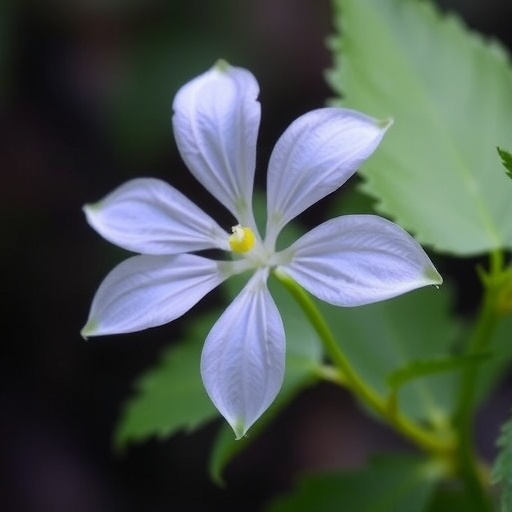In recent years, the search for natural remedies to combat a variety of health issues has experienced a resurgence. One such remedy that is gaining significant attention is the plant Merremia vitifolia, which has shown remarkable potential in the field of traditional medicine. The promising antipyretic properties of this plant, explored in a groundbreaking study, mark an important step in bridging traditional herbal practices with modern scientific inquiry.
The research, conducted by a team of scientists, delves into the time-honored use of Merremia vitifolia in traditional medicine, where it has been utilized for its fever-reducing properties. This plant, native to tropical regions, has been traditionally harvested for its leaves, roots, and stems, which are believed to contain bioactive compounds beneficial for reducing fever. The investigation into these traditional uses provides a foundation for scientific examination and validates long-held beliefs within indigenous communities.
The study employs molecular docking techniques to uncover the potential mechanisms behind the antipyretic effects of Merremia vitifolia. By simulating the interactions between the plant’s compounds and specific biological targets implicated in fever responses, researchers can predict how effectively these compounds may function in a clinical context. The study’s results not only showcase the efficacy of these natural substances but also highlight the importance of integrating indigenous knowledge with cutting-edge research methodologies.
Furthermore, the research addresses the specific bioactive compounds identified within the plant. These compounds play a crucial role in mediating the antipyretic effects, acting on key pathways that regulate body temperature and immune responses. For instance, certain flavonoids and alkaloids present in Merremia vitifolia have been shown to inhibit the production of pro-inflammatory cytokines, which are known to elevate body temperature during infections. This molecular-level insight bolsters the case for using Merremia vitifolia as a viable antipyretic agent.
The implications of this study extend beyond mere academic interest; they point towards a broader movement within modern medicine to revisit and validate traditional remedies, especially those derived from flora. By being agile enough to harness the wisdom of traditional practices while incorporating analytical techniques from contemporary science, there is a remarkable opportunity to create new avenues for treatment, particularly in areas lacking access to conventional medicine.
Moreover, the research reflects a paradigm shift in how scientists and healthcare practitioners view traditional medicine. No longer seen as mere folklore, these practices are now recognized as potential sources of novel therapeutics. As such, Merremia vitifolia serves as a case study for the broader potential of medicinal plants, fostering a greater understanding of their role in patient care and public health.
The detailed molecular docking studies conducted in this research allow for precise predictions about the efficacy and safety of Merremia vitifolia. By understanding how various compounds interact at the molecular level, researchers can refine extraction methods and dosages to maximize therapeutic effects while minimizing potential risks. This careful approach addresses the concerns of efficacy and safety as natural remedies become more mainstream in clinical settings.
Importantly, this exploration of Merremia vitifolia aligns with global efforts to promote integrative medicine, which combines conventional medical practices with alternative and complimentary strategies. As healthcare increasingly embraces this integrative philosophy, the inclusion of botanical sources like Merremia opens up exciting prospects for the future of healthcare.
Despite the promising findings, it’s essential to approach this research with a balanced perspective. While initial data suggests the potential of Merremia vitifolia as a reliable natural antipyretic, more extensive clinical trials and safety assessments will be necessary to substantiate these claims fully. Such research will be critical to convince regulatory bodies of the plant’s therapeutic relevance.
As scientists continue to explore the plant’s capabilities, it becomes paramount that cultural sensitivity is maintained, recognizing the traditional knowledge that has guided usage for generations. Respecting and honoring these indigenous practices is crucial as they form the backbone of much of the knowledge regarding the medicinal use of plants like Merremia vitifolia.
Moreover, the study reinforces the need for increased public awareness around the use of herbal remedies as complementary treatments. With the rise of global health challenges—such as antibiotic resistance and the aftereffects of pandemics—plant-based solutions may provide beneficial supplements to conventional care. This research may thus play a pivotal role in shaping future health policies and practices.
Finally, as the scientific community examines the comparative effectiveness of synthetic drugs versus natural alternatives, the results of this study pose compelling questions. Could Merremia vitifolia offer a more sustainable, accessible, and culturally resonant alternative to synthetic antipyretics? The answers may redefine how we view the intersection of nature and healing in the 21st century.
In conclusion, the revelations surrounding Merremia vitifolia exemplify the ever-evolving dialogue between tradition and innovation in medicine. As further research unfolds, the plant stands as a compelling testament to the untapped potential residing in nature, waiting to be explored and embraced in the quest for holistic health solutions.
Subject of Research: Herbal medicine, antipyretic effects, Merremia vitifolia
Article Title: Exploring the antipyretic efficacy of Merremia vitifolia (Burm. fil.): from traditional use to molecular docking insights
Article References:
Islam, F., Tawhid, M., Jan, M.E. et al. Exploring the antipyretic efficacy of Merremia vitifolia (Burm. fil.): from traditional use to molecular docking insights. Discov. Plants 2, 213 (2025). https://doi.org/10.1007/s44372-025-00301-5
Image Credits: AI Generated
DOI: 10.1007/s44372-025-00301-5
Keywords: Merremia vitifolia, antipyretic, herbal medicine, traditional use, molecular docking, biocompounds, integrative medicine




